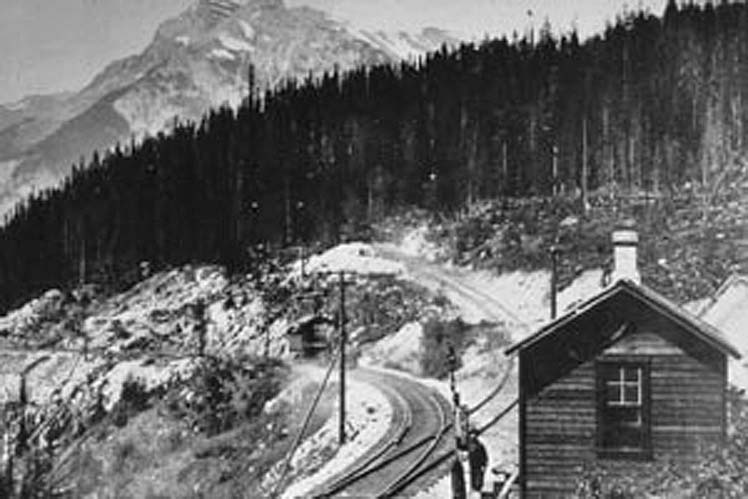
Kicking Horse River British Columbia - We're not getting the full story about the CP train crash just east of Field, in the Kicking Horse
Pass.
Train number 301 had crossed the continental divide, heading west.
It had stopped on a slight downgrade along the south shore of Wapta Lake, the last more or less level stretch before the track plunges down the steep hill to
Field, and from there on down the Kicking Horse River to Golden.
OKthePK Joint Bar Editor: News reports indicate the train was stopped at Partridge Siding, east of the upper Spiral Tunnel.
Perhaps "plunge" is an overly dramatic word for a two percent grade.
On foot, or in a car, you probably wouldn't even notice the slope.
But, for a 12,000 ton freight train, it's a serious descent, reputedly the steepest on any major line in Canada.
It used to be much worse.
When the rail line was first carved down the Kicking Horse canyon, the descent into Field was more than four percent.
Trains had to be divided into shorter units, shuffled down the Big Hill by special engines, and re-assembled in Field to continue west.
In hindsight, the Kicking Horse pass was possibly the worst possible route through the spine of the Rocky Mountains.
Both the Crow's Nest pass, farther south, or the Yellowhead much farther north, would have been better choices.
Survey parties also considered the Howse Pass and the Vermillion Pass more feasible.
But, CP brass and Ottawa politicians were in a hurry.
Get the line built, regardless, they demanded.
And the rail line has paid for their impatience ever since.
The hazards of the Big Hill were finally subdued by the construction of the world-famous Spiral Tunnels.
Instead of following the side of the mountains where the Kicking Horse river descends in a series of waterfalls, the CP tunnelled into both sides of the canyon
in a gigantic figure eight, that roughly doubled the length of the line and halved the grade.
These days, CP runs trains many times longer and heavier over that line.
The train that crashed had three engines, and 112 fully loaded grain cars.
According to reports, Train number 301 had been safely stopped for over two hours before it started down the hill towards Field.
It could not have been stopped without its airbrakes working.
While it stood still, a new operating crew took over.
And then, unaccountably, the train started to roll.
"It was not anything the crew did," senior investigator James Carmichael assured the media.
"The train started to move on its own."
That seems to contradict the basic laws of physics.
As Isaac Newton theorized, centuries ago, things do not move on their own unless a force is applied to them.
In this case, the moving force is obvious, gravity.
But gravity could only start the train moving if the equal and opposite force keeping it still for the last two hours was removed, the brakes.
Did someone release the brakes?
Conceivably, it could have been sabotage, by an unknown person.
Or did the brakes fail?
Which might point the blame at corporate maintenance practices.
Either way, a lot of questions remain answered.
Why didn't anyone notice that the train had started moving?
Did no one reapply the brakes?
Did anyone consider putting several thousand horsepower into reverse while the train was barely moving?
The three-member operating crew had to be on board, because they were killed in the crash.
They couldn't have leaped on several kilometres down the valley.
What did, or didn't, they do to stop the juggernaut as it gathered speed?
My math suggests that it must have taken the train up to half an hour, gradually gaining speed as it coasted for about six kilometres.
Were there no phone calls to the central dispatcher?
I accept that this is a tragedy.
I grieve for the families and friends of the dead men.
I grieve for all railway employees, suddenly reminded of the risks they take operating a very heavy object that can generate near-irresistible
momentum.
I also acknowledge that I have no railway experience.
I don't know what those three men could or should have done.
But, the facts available lead me to an uncomfortable conclusion, someone did something that enabled 112 freight cars and three engines to start rolling, to
build up speed through the Upper Spiral Tunnel, and finally to derail and crash into the Kicking Horse River.
Fortunately, the freight cars carried grain.
Had they been oil tankers, the devastation would have been far greater.
What really happened up there, that night, in the dark?
I wonder if we will ever know.
OKthePK Joint Bar Editor: The Transportation Safety Board (TSB) are pretty good at coming up with answers. We must wait and see.
Jim Taylor.
provisions in Section 29 of the Canadian
Copyright Modernization Act.

